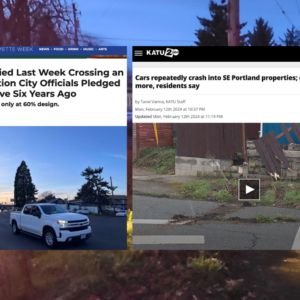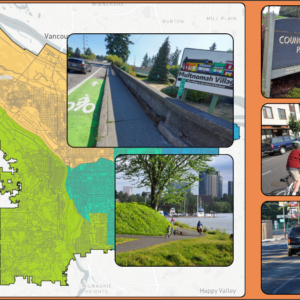
(Photo © J. Maus/BikePortland)
A major grassroots effort aimed at getting a statewide ban on studded tires is down but not out.
Jeff Bernards, the man behind the Preserving Oregon Roads campaign, posted a thank-you message on his website yesterday announcing the news: “… we were unable to raise the necessary funds needed to hire paid signature gathers. As a result we won’t make the ballot this November.”
Bernards believes the millions of dollars in road damage studded tires cause in Oregon each year should be put to other uses. He and his volunteers created a large groundswell of momentum for the cause; but in the end it came down to cold, hard cash. As we shared back in February, he needed to find a sponsor willing to part with about $200,000 to bring the campaign over the finish line. That sponsor never materialized.
Despite an all-volunteer force, Preserving Oregon Roads got over 10,000 people to sign the ban initiative forms. Given that impression showing of support, a company that manages signature campaigns all but guaranteed Bernards he would likely get the required 87,213 signatures if he could afford to hire them.
While the petition drive is over, there is still action in store for this issue. Bernards has laid a foundation of support and awareness and he’ll look to move the issue forward in Salem during the upcoming 2013 legislative session. Saying, “This is the beginning, not the end,” Bernards claims to have the support of 15 state legislators as well as many other local government officials.
“We have begun to build a coalition of Oregonians that want to preserve our valuable infrastructure,” says his statement, “and we won’t stop until we get studded tires off our roads.”
Bernards says that coalition and the facts on his side is enough to outplay the tire industry lobbyists who have tried to thwart this and similar ban attempts in the past (Bernards claims that Oregon-based company Les Schwab Tire Centers held up his effort in the Oregon Supreme Court, costing him eight crucial months of signature gathering time).
“It took five attempts to get women the right to vote in Oregon,” he said on the phone earlier today, “We’re not done with this yet.”
For more on this issue, read our past coverage and check out PreservingOregonRoads.org.





Thanks for reading.
BikePortland has served this community with independent community journalism since 2005. We rely on subscriptions from readers like you to survive. Your financial support is vital in keeping this valuable resource alive and well.
Please subscribe today to strengthen and expand our work.
Two questions:
1) Would this affect studded tires for bicycles as well? Usually such bans do not, but each one is a singular case, so….
2) Doesn’t such a ban make it more likely that motorists will slide into winter cyclists riding alongside them? I rather worry. Black ice is not uncommon in Portland, or the rest of Oregon.
“It is a woman’s duty to be delightful, ornamental, and useful, and she could not be more so with the vote. If she had it she would not know what to do with it. Where the ballot is placed in the hands of those unfit to use it there follows ruin, rapine, and terror. Let us not repeat previous disasters. Woman is no more fit for the ballot than to be a trapeze performer or bareback rider.”
Damn, and I just installed a trapeze…. 🙂
The use of the word ‘rapine’ in the quote above is curious. And the other nouns, too, are historically effects of typically male rage. So it seems the author’s concern was not with what women might do but what men who couldn’t handle the uppity women might do.
Is there a lesson here? Richard isn’t concerned with the (known) primary effects of a ban on studded tires, but (imagined) secondary effects precipitated by those who are assumed to be unable to handle driving with studless tires.
My studless snow tires work great on black ice. They are also much safer than studded tires for the other 99% of winter conditions that we encounter here. You should be more concerned about drivers with studded tires spinning out on the wet roads we have all winter than the extremely rare case of a car spinning out on black ice and hitting a cyclist that happens to be out on the road during black ice conditions.
You nailed it. I became a converted skeptic about 8 years ago, going from an AWD wagon with studs to a front-wheel-drive wagon with Blizzaks while living in the gorge. Had considerable opportunity to compare and no longer trust my life to metal studs. Their perceived effectiveness is a fallacy.
Always liked this quote:
“Let me tell you what I think of bicycling. I think it has done more to emancipate women than anything else in the world. It gives women a feeling of freedom and self-reliance. I stand and rejoice every time I see a woman ride by on a wheel…the picture of free, untrammeled womanhood.”
― Susan B. Anthony
Plus, it’s hot.
This makes me want to greatly reform (and limit) the initiative process. Initiatives are supposed to be an outlet for “people power” – a way for ordinary people to have an impact on state law. The fact that Bernards could not get his initiative to ballot without the $200,000 needed for paid gatherers shows how initiatives have swung too far towards being a tool of moneyed interests, not people power. I’d support (and donate money – though not $200,000 – to) an initiative to ban or severely restrict future initiatives! Or maybe only ban paid signature gatherers?
Alex- A ban on paid petition gatherers was thrown out by, I believe, the Oregon Supreme Court (free speech grounds, I think). We were able to institute a ban on paying per signature, which helps.
It barely helps. I worked as a signature gatherer a few years ago, and it was EXTREMELY CLEAR that if we did not make an hourly quota, we would be fired immediately. Even though I believed in the measure I was working for, the whole experience left me deeply frustrated with, nay, opposed to the initiative process. It’s not people power; it’s out-of-state money mutating our state and misleading voters into causing often dire damage to our prison system, tax base, ability to protect natural resources, and more. I now refuse to sign any ballot initiative and I encourage others to do the same.
I will vocally oppose this ban unless it explicitly exempts studded bicycle tires. Because I use them, and love them.
Also, while the proponents of the ban have good points that the new studless winter tires work VERY well on snow and ice for the vast majority of people (myself included), and about the road and environmental damage, those are reason enough to discourage the used of studs. You don’t need to resort to blatant falsehoods about studded tires not working on pavement. You may fool Portlanders with this, but Eastern Oregonians will call out this BS. (And don’t bother dragging out the Alaska study from 1996, or the plethora of more recent reports that cite it – it was already outdated then).
It is simply NOT true that modern studded tires are in any way dangerous on bare pavement, wet or dry. It WAS true many, many years ago, with heavy studs that sat in a rigid pocket in the tire, that the studs stuck out far enough (especially after some of the rubber had worn away) to impair the grip on the rubber of pavement.
Modern studded tires use lightweight carbide-tipped studs that wear at approximately the same rate as the rubber, and more importantly have an pocket of air or very soft rubber in the back of the stud cavity to ensure that the weight of the car pushes it back into the tire so that it only barely protrudes enough to contact the ice, compensating for any uneven wear and ensuring good rubber-pavement contact. There is no degradation of performance on pavement (other than noise, of course).
I’ve owned numerous sets of studded tires (though I stopped using them more than a decade ago), and when I read statements like “You should be more concerned about drivers with studded tires spinning out on the wet roads we have all winter” I can only ask WTF are you talking about? Maybe you had a bad experience with the primitive early studded tires, but those tires no longer exist. Mine worked just as well as non-studded tires on wet northwest pavement, as did those of every other skier I knew.
I too love my studded tires on my bike when I’ve honestly needed to use them – which is two days out of the last 5 winters. At least bike owners can swap them out easily enough whereas car owners don’t. And in my case, I have my studs on my old mountain bike and not on my regular commuter – this way, I don’t have to switch it out more than once at either end of the season.
You seriously have a set of studded tires for two days in the last 5 winters?
Yup. What I’m saying is, they only really made a distinct difference during the snowpocalypse a few years ago. I rode and flailed for a couple of days on slicks, and then put on the studded tires and was ever grateful.
Otherwise, even when it snows, I still ride with the slicks but just take it really, really easy. It’s only when we have black ice that the studs make a real difference – and it’s rarely thick enough for me to worry about putting the studs on.
This last winter when it started raining and freezing on the ground one night, I went out the garage and put them on. By morning, it was warm enough to not worry about it and rode my regular bike with slicks.
Maybe 2 days out of the last 5 winters if you stay in Portland.
I commute over the West Hills to Beaverton. Some winters (especially those with lots of clear mornings) I encounter frost a couple dozen times, and in even the mildest winters I run into snow and ice a few times.
Studded tires are also the Best Thing Ever for riding in leaf-strewn streets in November and December.
For most of the conditions we encounter here (i.e., we rarely have to deal with sheets of glare ice, or degraded, rutted, pitted ice as is common back east) a front studded tire is sufficient to keep you upright, and doesn’t add very much rolling resistance.
I’m going to guess studded bicycle tires can’t cause anywhere near the level of damage than studded tires on a multi-ton vehicle do.
Correct!
Correct!